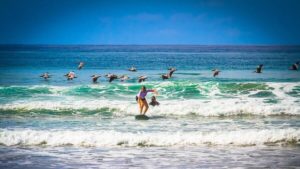What to Know Before You Go to a Surf Camp in Costa Rica

Costa Rica is a top destination for surfers, attracting beginners and experts alike with its warm waters and consistent waves. With over 800 miles of coastline on both the Pacific and Caribbean sides, the country offers a diverse range of surf spots. In recent years, surf tourism has grown significantly, making up a substantial portion of the country’s tourism revenue. For many, attending a costa rica surfing is the perfect way to dive into this vibrant scene.
The Rise of Surf Camps
Surf camps have become a popular trend for travelers seeking more than just a typical vacation. They offer an immersive experience that combines surf lessons with accommodation, meals, and a sense of community. The global surf camp market is expanding, and Costa Rica is one of its key hubs. These camps cater to all skill levels, from first-timers learning to stand on a board to seasoned surfers looking to refine their technique on world-class breaks. The structured environment helps newcomers learn the fundamentals of safety, etiquette, and wave dynamics in a controlled setting.
Choosing the Right Season and Spot
Understanding Costa Rica’s surf seasons is crucial for planning your trip. The Pacific coast generally sees its biggest and most consistent swells from May to November, during the “green season.” This period is often preferred by intermediate and advanced surfers. For beginners, the drier months from December to April offer smaller, more manageable waves, especially in regions like Guanacaste.
Popular surf destinations each have their unique appeal. Tamarindo is known for its lively atmosphere and beginner-friendly waves. Santa Teresa, on the Nicoya Peninsula, offers a more bohemian vibe with powerful beach breaks. Further south, areas like Dominical and Pavones are famous for their challenging waves that attract experienced surfers from around the globe.
What to Expect from a Camp
A typical day at a surf camp often starts early with a morning surf session, followed by breakfast and some downtime. Many camps also include video analysis of your surfing, allowing instructors to provide personalized feedback. Afternoons might involve a second surf session or other activities like yoga, exploring local towns, or simply relaxing by the beach. This all-inclusive model simplifies travel logistics, allowing you to focus completely on improving your surfing skills and enjoying the “Pura Vida” lifestyle that Costa Rica is famous for.
Tags: costa rica surf camp